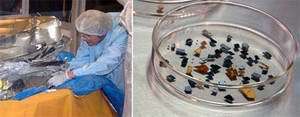Scientists surprised by solar wind data retrieved from Genesis mission

The 2004 crash-landing of a NASA capsule into the deserts of Utah had mission scientists fearing for a while that samples collected by the Genesis mission, sent to capture particles from the sun's solar wind, were lost to science.
But much of the collected material did survive the crash, and it's now turning up surprises: unexpected discrepancies between the composition of the sun and that of the inner solar system (which contains the sun's four closest planets, including Earth).
The early report, published online Monday in the journal Proceedings of the National Academy of Sciences, shows among other things that the pattern of isotopes in the solar wind (and thus, presumably, the sun) is very different from that of the inner planets.
Genesis launched in 2001 and flew to a point nearly 1 million miles from the Earth to collect solar wind particles - blown off the sun's surface at high speeds - from a region in space unaffected by the Earth's magnetic field. The spacecraft was starting to land, samples safely tucked away, when its parachute failed to deploy and the capsule smashed into the ground.
"Coming back to Earth was not a happy event for us," said mission principal investigator Donald Burnett, a geochemist at the California Institute of Technology. "We literally went out and picked up the pieces in Utah and came back - and managed to pick out some important science."
Like the planets, the sun contains various amounts of oxygen, nitrogen and other elements. But each element can come in heavier or lighter forms, called isotopes, depending on how many neutrons they have. The proportions of heavier oxygen to lighter oxygen, and so on are a feature that cosmochemists thought the planets would share with the sun, since they were ultimately formed out of the same coalescing cloud of dust and gas.
But it appears that there are significant differences. The Earth, for example, has more heavier oxygen in relation to lighter oxygen than does the sun - and that is at odds with current theories of space chemistry.
"We used to think that the sun and solar system were all made of the same stuff and things were pretty well mixed up," said Andrew M. Davis, a cosmochemist at the University of Chicago who chairs an independent committee that helps decide who in the scientific community gets to use the retrieved samples. "But somehow the sun ended up a little different from the Earth. We haven't figured out what it all means yet - but it's clearly important and it's making people rethink old ideas."
A broader report on findings from the mission is planned for publication within the next few weeks.
(c) 2011, Los Angeles Times.
Distributed by McClatchy-Tribune Information Services.
















